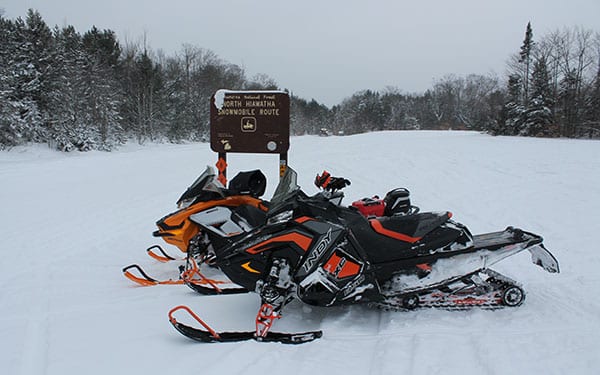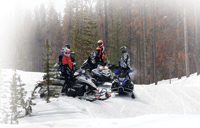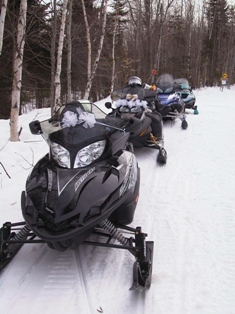It was a friend who talked Edward Thorne into taking an after-dark snowmobile ride in the winter of 2000. They were on a trip near Marquette, Michigan.
While on the ride, Thorne noticed fresh tracks that veered off the trail to a railroad grade — which was also marked for no trespassing.
“Me being a dad, a husband and having kids around, I just had that gut feeling — the one you get when one of your kids is hurt,” he said. He parked his snowmobile, jumped on the back with his friend, and followed the tracks to what he described as a “horrific crash.” A 21-year-old snowmobiler had hit a cable.
“We came upon his buddy, who was trying to do what he could,” Thorne said. “He was nearly cut in two. But before I even got up to them, I could smell the alcohol.”
The culture of alcohol use and snowmobiles has come under recent public scrutiny with the high-profile death of Chicago newscaster Randy Salerno in northern Wisconsin in January 2008. He wasn’t the only fatality in Wisconsin last winter — and not the only alcohol-related death. In the 2007-08 season, 25 people died on Wisconsin trails; 18 of them, or 64 percent, involved alcohol. Wisconsin is not alone; other states have similar snowmobile/alcohol-related death percentages.
Undercover investigations by mainstream media portray snowmobilers as having late-night, alcohol-infused orgies with horsepower. Within the snowmobile community, there’s debate on how to approach the use of alcohol and the sport of snowmobiling. Laws on alcohol use and snowmobiles vary from state to state, as do opinions on how to handle the combination of the two.
On that night in Michigan, something snapped with Thorne. “I was on vacation. I was going to take two weeks to ride and have fun. It was something I’d been doing for 14 years,” he said. “I said, ‘That’s it. Something has to be done about drinking and riding.’”
Thorne, of Kimberly, Wisconsin, founded an organization called Snowmobilers Against Drunk Riders (SADR). When his seasonal employment ends each fall, he devotes his time to raising awareness of the consequences of alcohol intoxication and snowmobiling. He’s had varying success with his goals. He’s been able to catch the attention of some Wisconsin lawmakers when lobbying for stricter intoxicated snowmobiler legislation; he’s met with resistance when posting “don’t drink and ride” information at bars.
“I want there to be a logo at establishments, something that reminds snowmobilers that they don’t have to get hammered up to have fun,” Thorne said. “I ride fast, I ride hard, but when I have a drink, I park my sled and I’m done for the day.”

Done For The Day
Directors from the Michigan Snowmobile Association (MSA) were on a group ride in 2000. They stopped at a bar to get some food, and a few members ordered a beer.
“There were 12 or 15 of us, and maybe two beer bottles on the table,” said Bill Manson, executive director of MSA. “Someone walked by and said, ‘Look, there’s a group of MSA officers and they’re all drinking.’ At that point, we knew that, as an association, we’d have to take the higher road. I don’t think it’s wrong to have a beer and a burger; it’s the image it presents. We can dance around the subject all we want, we can say ‘know when to say when’ or other campaigns, but bottom line is that there is only one safe stance to take.”
MSA adopted a strict policy of zero-tolerance during any association ride. It also asked its membership to do the same in their personal snowmobile activities by taking a zero-tolerance pledge while riding. More than 15,000 snowmobilers returned a “pledge” postcard to the MSA office that season, and received a special sticker and luggage tag in return. The following season, MSA had 100,000 stickers and tags printed. “We had to re-order five years later,” Manson said. MSA also added increased alcohol awareness education to its youth safety training, did a billboard campaign and sponsored zero-tolerance poker runs — all were deemed successful.
The program’s biggest success is with public perception. “Our negative press has gone down over the years because of zero tolerance,” Manson said. When members of the media call for an MSA comment on alcohol-related accidents, Manson points to the zero-tolerance stance.
The stance wasn’t without some cost. The organization lost some members, and enforcing zero-tolerance on rides wasn’t always easy, even among the board members. Manson recalled telling a long-time board member that if he ordered a beer, he’d have to sit at a separate table, ride home by himself and remove himself from the board.
About the same time, MSA pushed for legislation to link alcohol-related snowmobile offenses to a driver’s motor vehicle license points. Minnesota has a similar law; Wisconsin and New York do not.
Fatality data before and after the zero-tolerance program is not conclusive to its effectiveness. In the 2006-07 season, 67 percent of fatal snowmobile accidents in Michigan involved alcohol; in 2007-08, it was 38 percent. In the past 10 years, however, there’s been a general decline in overall fatal accidents. The season with the most fatalities (46 in 2002-03) had a lower-than-average percentage of alcohol involvement — 45 percent.
Michigan isn’t the only place snowmobilers hear a strong zero-tolerance message. The four snowmobile manufacturers adopted a “drinking and snowmobiling don’t mix” policy in 1995; the Canadian Council of Snowmobile Organizations works with MADD Canada to promote zero-tolerance throughout the country. The American Council of Snowmobile Organizations has a voluntary zero-tolerance program for its member states. The International Association of Snowmobile Administrators, made up of state and provincial trail administrators, is working on its own zero-tolerance campaign.
At the International Snowmobile Congress in 2002, snowmobile state and provincial associations adopted MSA’s zero-tolerance program, which includes the ditty, “Zero tolerance I say ’til I’m done for the day.” Despite strong initial support for the zero-tolerance message, Manson said many states have gone back to a “drink in moderation” stance.
“One part of the public is 100 percent for [zero-tolerance], the other part of public says that they don’t think there’s anything wrong with stopping for a burger and an alcoholic beverage at lunch,” said Gary Eddy, for the Wisconsin Bureau of Law Enforcement in the Department of Natural Resources. “I think they’re missing what the zero-tolerance message means. It’s the best policy to guarantee your safety and the safety of others. I don’t think anyone can argue that it isn’t the best policy.”
On The Trail
When the phone rings in the middle of a winter night, Jim Jung knows it’s going to be bad news. As a conservation warden for the Wisconsin Department of Natural Resources in southern Oneida County and an expert in snowmobile accident reconstruction, he’s typically one of the first people on the scene of a fatal crash.
He describes gory accidents in a matter-of-fact manner, such as the rider who hit a lake embankment too hard, lost control, launched through a basement door and went head-first into a chest freezer — helmetless. A game of chicken where neither backed off. A shallow-water drowning while pinned under a snowmobile.
Throw in aggravating factors such as spotty cell phone service, imprecise location information or longer response times and accidents can turn into desperate situations. In his experience, nearly 80 percent of snowmobile fatalities involve alcohol; speed is also a contributing factor.
The ones that get him, though, are the young fathers. “I had a fatal where the wife was pregnant with her third child, and the other two were under age seven,” he said. “She called me a day or two after the accident, wondering how much he’d had to drink. I just thought, ‘Man, that’s got to be a terrible thing for her to go through.’ A lot of people don’t think of the long-term consequences.”
Jung’s territory, which includes Rhinelander, is a popular snowmobile area with some of the highest rates of snowmobile fatalities. He’s worked there for 16 years, and knows exactly when snowmobiling shifts from a fun activity (daylight hours to early dusk) to a potentially dangerous game (after 9 p.m. on a weekend).
While the Wisconsin DNR promotes zero-tolerance, Jung’s not against snowmobilers having a drink or having fun. “I think a lot of us in the field realize that people are up here recreating, they’re going to go to dinner and have a drink or two,” he said. “Responsibility is what I’m looking for.”
Jung’s job isn’t limited to accident duty; it’s also his job to hand out penalties — including citations for intoxicated snowmobiling.
While drunken snowmobilers come in all genders and ages, Jung said he sees the most violations from white males between the ages of 25 and 39. Eddy’s statistics add that 46 percent of people arrested for intoxicated snowmobiling also have a similar violation on another motor vehicle. Minnesota statistics also confirm a pattern of habitual, multi-vehicle offenders.
In Wisconsin, as well as Minnesota, snowmobile sobriety checkpoints are not allowed. Jung looks for other reasons to stop snowmobiles — speeding, stop-sign violations, illegal lights — and then checks for alcohol.
Jung always asks how many miles the rider has driven. He calls the high-mileage driver “active and hardcore” and less likely to drink. “If they’ve been out all day and have only gone 40 to 60 miles, and now it’s 2:30 in the morning, you know what they’ve been doing,” he said.
The state of Wisconsin is fully staffed with 170 field wardens, and includes a specially trained snowmobile accident reduction team that travels to snowmobile areas during high-traffic events, as the budget allows. The visibility isn’t enough for Eddy’s tastes, and he relies on local sheriff patrols to pitch in.
The enforcement budget is set in advance, and Eddy hopes each year that it will last for the entire season. In the 2007-08 season, the enforcement budget dried up about a month before the end of the season. Eddy said he has, in work hours, the equivalent of nine full-time snowmobile patrol jobs; he did an analysis a few years ago that indicated the demand required the equivalent of 12 to 14 full-time workers.
The Business End
Bosacki’s Boat House in Minocqua, Wisconsin, has one of the must-see bars in Northern Wisconsin. It’s a beautifully carved, turn-of-the-century oak masterpiece in a family-owned establishment that welcomes boaters in the summer and snowmobilers in the winter.
Owner Harlan Bosacki makes it clear that his business is a supper club — not a bar — and that its main sales come from food. He said he doesn’t get late-night, barhopping snowmobilers at his place, though he does serve plenty of snowmobilers. His bartenders all take a state-required alcohol-awareness course on how to spot intoxicated patrons.
It only takes a glance at a Wisconsin trail sign to see which establishments serve alcohol — it’s indicated with a martini-glass symbol. These bars, often far removed from the main roads, count on snowmobilers for wintertime income.
Trails in Wisconsin, as well as in neighboring states, travel from bar to bar. It’s a vestige of the early years of trail building, and in many cases, bar and restaurant owners are active, supportive members of local snowmobile clubs. Bosacki is a good example. He no longer does the physical end of trail upkeep, but he donates to snowmobile causes.
This support is part of the reason the Association of Wisconsin Snowmobile Clubs (AWSC) has cried foul to alcohol-free snowmobiling. Business owners also balk at the zero-tolerance message, instead citing personal choice and business sense.
Bosacki said claims of Wisconsin bartenders over-serving patrons, as claimed by mainstream media, is rubbish. “It’s not a matter of over-service. Everyone has a different tolerance to alcohol, and the bartender doesn’t know how much that person has already smoked, shot or snorted before coming to the bar,” he said. “Then you serve them one drink and they go out and get killed. Whose fault is it? Nobody up here is intentionally over-serving anyone. I’ll cut off so fast I’ll make your head spin. I don’t think any bar owner truly wants to hurt their customers. We want them to come back.”
Pete Madland, executive director of the Tavern League of Wisconsin, calls zero-tolerance programs “draconian.”
“We would not agree to a zero-tolerance message,” he said, “I think a person can go out, have a drink and snowmobile responsibly. People do it every day, and do it responsibly. I guess our stand is ‘don’t ride drunk.’ We don’t support drunk snowmobiling. We do think it’s all right to have a drink and ride a snowmobile, though.”
Manson said his feedback from bar owners has been positive, generally, as they have not seen decreases in overall revenues. “The bar owners tell me that their food bills have stayed the same, but that revenue from beer and wine is down during the day,” he said. “But they also say they make more on pop, hot chocolate and coffee.”
Larry Sevenski, owner of Larry’s Seven-Ski Inn in Elmira, Michigan, said he’s seen a change in clientele habits. Liquor and beer sales are down; food and non-alcoholic beverage sales are up. It used to be that two-thirds of patrons would order alcohol; now it’s at about a third. Margins on alcohol versus non-alcohol drinks are about the same, he said.
Still he doesn’t agree with a zero-tolerance message. “Why are snowmobilers singled out more than driving a car or a boat?” he said. “Having one or two drinks is not drunk driving.”
Bosacki said that an all-around zero-tolerance policy would kill alcohol-serving businesses. “You should be able to have a couple of cocktails, go out and have some fun,” he said.
That said, he has little patience for drunken snowmobiling, particularly with high-horsepower sleds. He said he’d support linking intoxicated snowmobiling offenses to a person’s driving license. “Alcohol, drugs and speed is what’s killing people on the trails,” he said.
That type of law may not be far off in Wisconsin’s future. Such a law failed in 2000, but Eddy said it might come up again. “It would be an added deterrent, and we do have reciprocity with other states,” he said, adding that if people need their motor vehicles, they’ll start making the right choices.
“This would be a good way to increase safety and enjoyment,” Eddy said. “We will start seeing an increase of families out there snowmobiling. Every season, we hear that people won’t ride at night or on weekends because drunks and crazies are on the trail. It’s a terrible thing to hear that people are afraid to be on public trails.”
Legal Overview
Minnesota: .08 BAC; violations tie into driver’s license. Potential charge of a misdemeanor, gross misdemeanor or felony-level Driving While Intoxicated (DWI). Misdemeanor penalty may include up to a $1,000 fine, possible jail sentence and loss of snowmobile operating privileges for one year. Gross misdemeanor charges apply for .20-or-higer BAC and includes up to $3,000 in fines, loss of motor vehicle driver’s license and loss of license plates. Snowmobiles are subject to seizure.
Michigan: BAC of .08 percent; violations tie into driver’s license, up to six points.
Wisconsin: BAC of .08 percent; fine of $627 for first offense. A second offense within five years is a criminal offense with jail time. Snowmobiles cannot be seized by arresting wardens.
Ontario: BAC of .08; operating a snowmobile under the influence of alcohol is a criminal offense and carries the same penalties as driving a car, which may include license suspension and a $600 fine for a first offense.
New York: BAC of .08 percent; court can suspend riding privileges and registration. A rider who refuses a breath test receives a suspension of the privilege to operate a snowmobile, pending a DMV hearing.
New Hampshire: BAC of .08 percent; snowmobiling while intoxicated is a criminal offense. It includes fines up to $1,200 and loss of snowmobile operation privilege for a minimum of 90 days and a maximum of 180 days for the first offense. Non-residents may lose riding privileges at home due to reciprocity agreements. Sobriety checkpoints are legal.
Intoxicating Facts
- Since the 1997-98 snowmobile season, there have been 643 convictions for intoxicated snowmobiling in Minnesota.
- A 10-year study of Manitoba snowmobiling injuries found that 88 percent of the patients had consumed alcohol before their injuries; 70 percent of the patients had a blood alcohol level more than 0.08 percent.
- Since 2003, the majority of Wisconsin snowmobile fatalities have taken place in two counties: Vilas (20) and Oneida (19).
- In the 2007-08 season, alcohol was noted in 38 percent of snowmobile fatalities in Michigan; 64 percent in Wisconsin; and 44 percent in Minnesota.
- In a 17-year snowmobile fatality study in Ontario, males accounted for 91.2 percent of the 548 deaths and were a median age of 30 when killed, while females were 24.
- In that same study, more than three-quarters of all snowmobile fatalities occurred in single motor vehicle collisions and 83.2 percent of snowmobile drinking and driving fatalities occurred in single-vehicle collisions.



